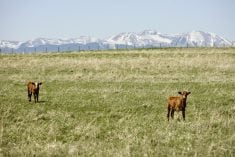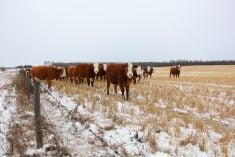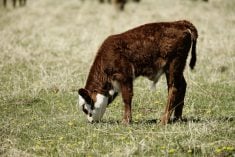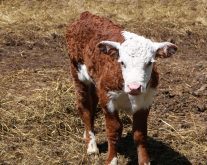Cow-calf producers across North America face wide-ranging challenges each calving season but scours and neonatal diarrhea often top the list. Various systems are used to help prevent what can become devastating losses when these pathogens gain a foothold.
An established approach still growing in popularity is the Sandhills calving system, designed to separate newborns and older calves when scours and neonatal diarrhea challenges are strongest.
Dr. David Smith is a professor and associate dean for research and graduate studies at Mississippi State University. When he worked as a University of Nebraska extension veterinarian, he and his colleagues had little success when they first studied calving season scours by investigating the intricacies of disease pathogens. But when they looked at time frames, they saw a pattern.
Read Also

Canadian Beef Check-Off Agency reports on investments and activities
The check-off agency’s work behind the scenes is what ensures cattle check-off dollars are invested wisely, accounted for transparently and deliver measurable value back to producers and importers.
“In a typical beef herd, the first calves born were not the ones getting sick,” Smith says. “The later calves displayed an increasing sickness rate over time.”
They determined once the calves were about two weeks of age, they were shedding pathogens which were multiplying throughout the population. As more calves reached this age, the risk to the newborns intensified as the pathogen load increased. Through trial and error, Smith’s team segregated older calves from newborns by moving pregnant cows from cow-calf pairs roughly every two weeks.
“It works because we avoid the multiplication factor,” he says. “The first calves born are only exposed to a relatively low dose of pathogens from the females. They do become infected but not enough to make them sick.”
Smith says as calves get older, they become the cell culture media that harbours the virus, which multiplies over time. Each newborn receives a larger and larger dose from older calves. This becomes a strong exposure as the virus is continually passed on, delivering greater dose loads which eventually overwhelm immune systems. Segregating calf groups by age keeps the virus load lower by cutting out this multiplication effect, effectively delivering much lower doses of the virus.
- READ MORE: Surviving scours
Consider management factors
Smith found the Sandhills system is successful on the same land base year after year as pathogens don’t survive both extreme cold and heat.
“When manure and bedding are hauled away the pathogens are gone,” he says. “It’s the cow herd that is the pathogen reservoir. Viruses are maintained in the adult animals, not from one year to the next on the same pasture. This is even more true in Canada with severe cold and plenty of sunshine during the summer months.”
Two practices make the strategy more management friendly. One is maintaining a tight calving season. The other is the ability to mix pairs, if necessary, once calves are older than four weeks, if they’re not relocated to previously used fields.
An extended calving season requires more land for the calving area. A tight breeding season, with many females conceiving early, delivers more calves of the same age to fewer pastures.
Depending on the calendar month, mixing the older calves often coincides with spring turnout, reducing the risk as most calves are old enough that they’re not so susceptible.
Practices to avoid
However, operations that use a centrally located calving barn to shelter animals from weather will face challenges with this system.
“This is a problem when all cattle are calved in the same barn,” Smith says. “When they leave this communal facility, it’s already too late. Age segregation at this point doesn’t work because the barn they all came through becomes the pathogen source, giving each newborn a full dose.”
He explains it’s important calves are born on a pathogen-free surface. When calving every two weeks on clean ground, new calves are only exposed to the low dose the cows are shedding.
For herds calving in colder weather, if possible, it’s best to use portable facilities to assist pregnant cows.
This can be a significant obstacle as cold and potentially stormy weather may become a bigger risk to newborns than neonatal diarrhea. Each pasture will need windbreaks, trees, bushes or gullies for protection from wind, snow, ice and harsh temperature extremes.
“Weather inevitabilities need to be a big part of planning,” Smith says. “Balance the infrastructure, land features or protection facilities a farm might need to erect. It may come down to moving the calving season back to counteract these weather challenges.”
Water sources and fencing are also hurdles to consider and overcome as water must always be available along with permanent or portable cross-fencing.
When used properly, the Sandhills calving system successfully counteracts scours. Smith points to test trials in drought conditions where operations have even used drylot settings in feedlots or hoop barns to maintain age segregation. Cows were rotated through a series of pens with excellent success.
“If producers aren’t sure they have enough viable pastures, we’ve found having groups on either side of fence lines, and even sharing water tanks is still safe,” Smith says. “What doesn’t work is when groups are moved through a series of pastures and then returned to a previously used paddock.”
He emphasizes it’s important to keep in mind the Sandhills calving system is not something everyone needs to use but works best for those suffering major losses due to scours and neonatal calf diarrhea.
“If a ranch is losing 10 or 15 per cent of their calves to scours and diarrhea, it’s probably a bigger hit than most winter storms are,” he says. “We might gamble on storms in hopes of reducing losses due to diarrhea.”
















